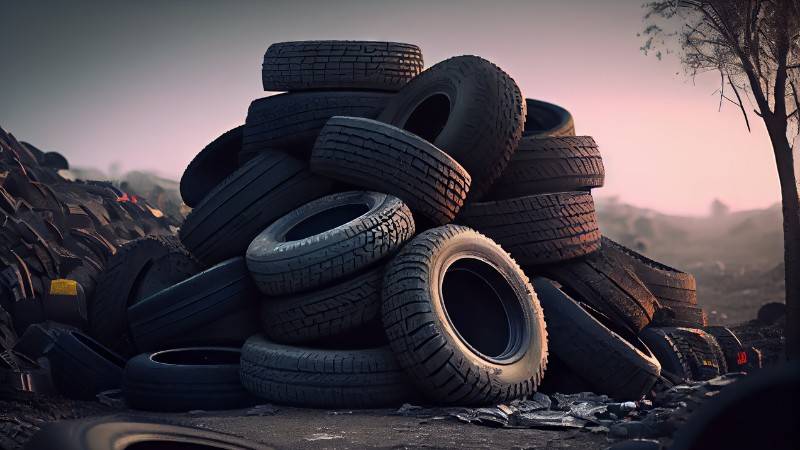If you’re like me, you’ve probably been diving deep into the world of recycling and sustainability, always on the lookout for ways to make our planet a bit greener. Today, I want to shed some light on a topic that’s been on my radar lately: tire recycling.
Did you know that end-of-life tires (ELTs) account for nearly 2% of total global waste? That’s a staggering number, especially when you consider the environmental and health hazards posed by improper waste management of these tires. In fact, the European landfill directive has been pushing for more efficient treatments, making Europe a world leader in waste tire recycling. But there’s still a long way to go.
Now, you might be wondering, “Can you recycle tires?”
Absolutely! And the importance of doing so cannot be overstated. With the rise in new car production, the ELT waste problem is only set to grow. In 2021 alone, 75.8 million new cars were sold globally. By 2040, we’re looking at a world with 2 billion cars and 790 million trucks.
That’s a lot of tires that will eventually need recycling!
So, let’s dive into the world of tire recycling, explore its significance, and understand how we can all play a part in this crucial eco-journey.
What Are Tires Made Of?
Diving deeper into our sustainability journey, let’s unravel the mystery behind the composition of those round, rubbery things we see on every vehicle – tires.
If you’ve ever had the chance to handle used tires or even new tires, you might have wondered about the materials that give them their unique properties. So, let’s break it down.
Tires are complex structures, and while rubber is the primary material, it’s not the only one. In fact, some tires are composed of as many as 200 different raw materials. These materials are combined with rubber compounds to create the various components of a tire’s construction.
Typical Composition of a Tire
| Material | Percentage by Weight (Passenger Tire) |
|---|---|
| Natural Rubber | 14.00% |
| Synthetic Rubber | 27.00% |
| Carbon Black | 28.00% |
| Steel | 14-15% |
| Fabric, fillers, accelerators, antiozonants, etc. | 16-17% |
Source: https://p2infohouse.org/ref/11/10504/html/intro/tire.htm
The rubber compounds in tires are quite diverse. For instance, the tread of a tire might contain 50% natural rubber and 50% styrene-butadiene rubber, while the sidewall might have a higher percentage of natural rubber. These compounds are meticulously chosen to ensure quality tires that can withstand various terrains and conditions.
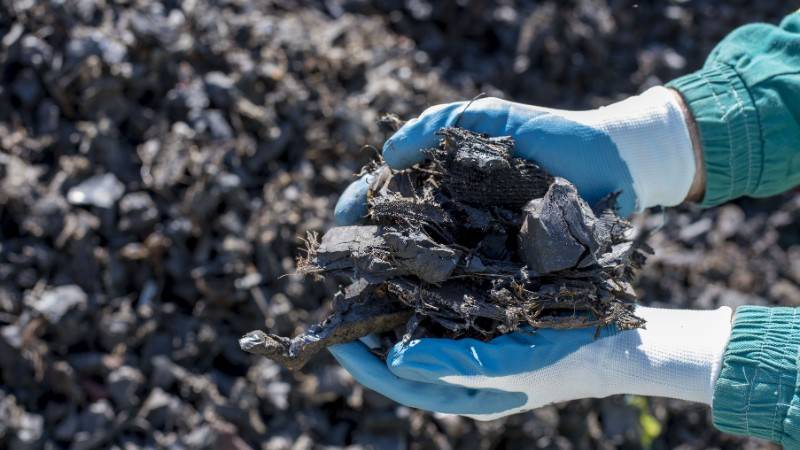
But it’s not just about rubber. The steel in tires, especially in the belts and bead wire, plays a crucial role in giving the tire its shape and strength. There’s approximately 2.5 pounds of steel belts and bead wire in a passenger car tire. This steel is specially designed for high tensile strength, ensuring that our tires can handle the pressures of the road.
Now, you might be thinking about the old tires lying in your garage or the scrap tires you’ve seen at local dumps. With such a mix of materials, recycling tires becomes a challenge but also an opportunity. The recycled material, especially crumb rubber, has numerous applications, from playground surfaces to road construction.
In our next section, we’ll delve deeper into the world of tire recycling, understanding the processes and the benefits it brings to our environment.
Are Used Tires Bad for the Environment?
Carbon Footprint of Tire Production

Tire production is a resource-intensive process. A significant portion of tires is made from natural rubber, primarily sourced from rubber trees (Hevea brasiliensis) in Southeast Asia.
These trees take five to six years to mature and need to be sapped daily for the next 20-25 years. Instead of this scarce resource, synthetic rubber can be used, but it comes at a hefty environmental price: one barrel of oil per tire.
Every new tire produced chips away at our limited natural resources.
Furthermore, the production process itself is energy-intensive, leading to emissions and waste. While some of these resources can be recovered if the tires are recycled at the end of their life, many tires don’t get this second chance.
Instead, they end up as waste tires in landfills or as scrap tires in vacant lots, further exacerbating the environmental issues.
Environmental Impact of Discarded Tires
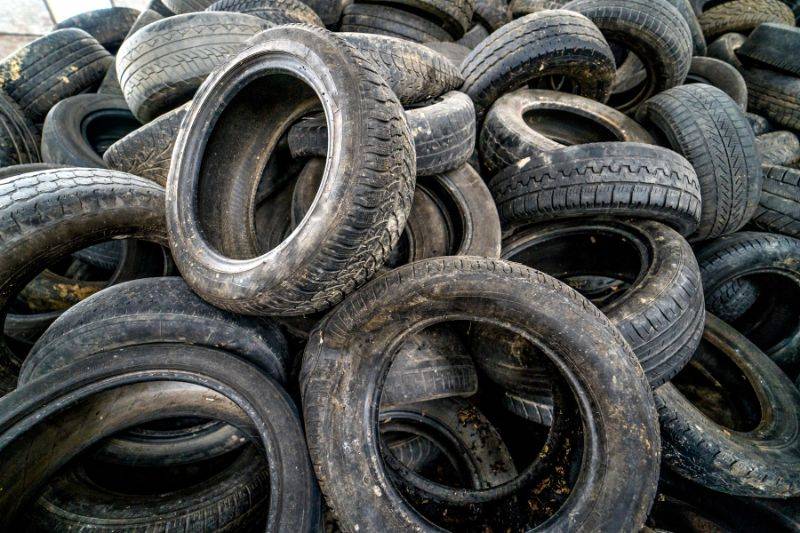
When we talk about the environmental impact of discarded tires, the picture isn’t pretty. Improper disposal of used tires poses significant environmental challenges.
For starters, tires don’t decompose easily. When they accumulate in landfills or junkyards, they release harmful chemicals into the air, ground, and water, disrupting the ecosystem. Just by being exposed to the sun, a waste tire emits methane gas, a potent greenhouse gas that exacerbates climate change.
But the problems don’t stop there!
If a tire catches fire, it releases clouds of toxic black smoke laden with the chemicals used during tire manufacturing. These fires are notoriously hard to extinguish, and using water can wash away these chemicals, leading them to contaminate our groundwater, lakes, and ponds.
Moreover, simply placing tires on the ground for extended periods can kill beneficial soil bacteria, which are crucial for the nourishment of various plant and animal species.
And let’s not forget the breeding grounds these tires become for pests. The open center of a tire, when filled with rainwater, becomes the perfect breeding spot for mosquitoes, which can transmit diseases like West Nile Virus.
How to Recycle Tires
Alright, now that we’ve delved into the composition of tires and their environmental impact, let’s address a pressing question: how can we, as individuals, contribute to the solution?
Recycling tires might seem like a daunting task, but with the right steps, it’s easier than you’d think.
Here’s a step-by-step guide to help you navigate the process:
Preparing Your Tires for Recycling

Assess the Condition
Before you consider recycling, check if your old tires can be retreaded or repaired. This not only prolongs the life of your tires but is also a more economical option than buying new tires.
Clean and Store
If you’ve decided to recycle, ensure the tires are free from dirt and debris. Store them in a cool, dry place away from direct sunlight to prevent any damage or wear.
Remove Rims and Wheel Weights
If you’re recycling tires yourself, you’ll need to remove the rim and wheel weights first. The rim is typically made of aluminum, and the weights are made of steel — both valuable metals that can be recycled separately. However, if you’re not comfortable with this step, many recycling centers will do it for you, albeit possibly at an additional cost.
Consider Reuse
Before heading to the recycling center, think about potential reuse projects. Old tires can be transformed into garden planters, compost bins, or even tire swings. Repurposing not only gives the tire a second life but also reduces the need for recycling.
Understanding The Tire Recycling Process
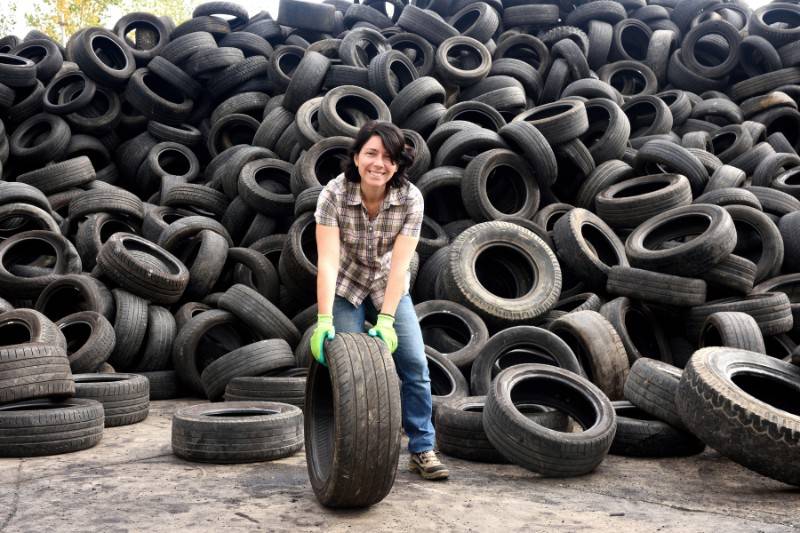
Find a Recycling Center
Not all recycling centers accept tires, so it’s essential to find one that does. Many auto shops offer tire recycling services, especially if you’re buying new tires from them. Some might even recycle your old tires for free or for a nominal fee.
Drop-off or Schedule a Pickup
Depending on where you live, you might have to drop off the tires at the recycling center. Some municipalities offer special pickups for items like tires, so it’s worth checking with your local waste management service.
Understand the Recycling Process
Once at the recycling center, tires typically undergo shredding or grinding. The shredded material can be used for various purposes, from rubberized asphalt to playground mulch. Some parts of the tire, like fiber and steel, are separated and sold to other industries. The rest, especially crumb rubber, finds its way into various applications.
Where to Recycle Tires?

Recycling tires is a commendable step towards a sustainable future, but knowing where to recycle them is equally crucial.
Here’s a guide to help you find the right place:
Local Drop-off Points and Collection Programs
Local Recycling Centers: Many recycling centers accept tires, but it’s always a good idea to call ahead and confirm. Some might charge a nominal fee, while others might offer the service for free, especially if you’re buying new tires from them.
Auto Shops: Many auto shops offer tire recycling services. If you’re purchasing new tires, they might even recycle your old ones for free or for a small fee.
Municipal Collection Programs: Some municipalities have special collection programs for items like tires. Check with your local waste management service to see if they offer tire pickups or have designated drop-off days.
Green Directory For Recycling Tires
One of the most comprehensive tools to find recycling facilities is the Green Directory from GreenCitizen. This directory allows you to find all nearby “green” facilities.
Whether you’re looking to recycle tires, electronics, or even hazardous waste, the Green Directory has got you covered.
To use the Green Directory:
- Visit the Green Directory on GreenCitizen's website.
- Type in "Tire" or "Used tires" under the Search For text box
- Enter your preferred location directly or ZIP code
- Hit the Search button
- Once you've identified a facility, you can get details like their address, contact number, and the materials they accept.
How Are Tires Recycled In Recycling Centers?

Tires, given their durability and composition, pose a unique challenge when it comes to recycling. However, with the right processes in place, these challenges can be overcome, turning old tires into valuable resources.
Let’s delve into the intricate process of tire recycling:
Collection of Old Tires
The journey of a tire from being discarded to being recycled begins with its collection. Tires that have become unsuitable for use on vehicles due to damage or wear are collected from various sources.
This includes auto repair shops, tire vendors, and even local recycling services.
Some tire manufacturers, like Bridgestone with its Tires4ward program and Firestone with its Spent Tire Initiative, actively participate in tire collection.
This ensures that for every new tire sold, an old one gets recycled.
Initial Sorting and Inspection
Once collected, the tires undergo an initial inspection. This step determines the condition of the tire and whether it can be retreaded or repaired.
Tires that are still in good condition might be retreaded and sold again, offering a more sustainable and cost-effective solution than producing new ones.
Those that can’t be retreaded are sent for recycling.
Shredding and Grinding
The core of the recycling process involves shredding the tires. Special machinery is used to break down the tires into smaller pieces, making them easier to process.
This shredded material can be further refined, leading to products like ground rubber or even smaller crumb rubber.
These products find various applications, from playground surfacing to rubberized asphalt.
Further Processing and End Products
Post-shredding, the tires undergo further processing based on their intended use. For instance:
1. Tire-Derived Fuel (TDF)
A significant portion of the scrap tire material is used to produce tire-derived fuel. This fuel can produce the same amount of energy as oil and even 25% more energy than coal. The ash residues from the TDF process may contain lower heavy metals content, making it a cleaner alternative to some coals.
2. Civil Engineering Projects
Some shredded tires are used in civil engineering projects, aiding in landslide repair, embankments, and even road paving when mixed with asphalt.
3. Material Extraction
Since tires consist of materials like steel, fiber, and nylon, it’s possible to extract and clean these materials for use in other products.
Innovative methods are continually being developed to recycle tires. For instance, a team of chemists at McMaster University recently discovered a way to break down the rubber used in car tires to turn them into new ones, showcasing the potential for sustainable tire recycling.

Read More:
How to Upcycle Tires: What To Do with Old Tires?
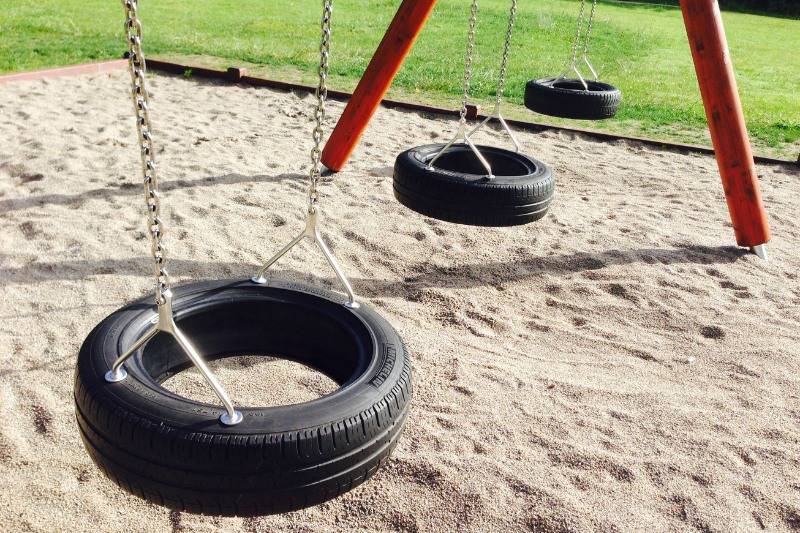
Tires, with their durability and unique structure, aren’t just meant for the road. They can be transformed into functional and aesthetic pieces that can add value to our homes and gardens.
Upcycling tires is not only an environmentally friendly practice but also a creative way to repurpose something that might otherwise end up in a landfill.
Let’s explore some innovative ways to breathe new life into old tires:
DIY Ideas for Repurposing Tires at Home
1. Make A Dog Bed
Old tires can be turned into cost-effective dog beds. Clean the tire, paint it to fit the aesthetic of the room, and fill the middle with comfortable padding for your furry friend. The tire’s natural grip and weight make it a stable bed.
2. Create An Outdoor Tire Chair
Depending on your crafting skills, old tires can be transformed into simple or intricate outdoor chairs. They can serve as the base for the seat, with cushions added for comfort. Paint or decorate them to match your backyard’s theme.
3. Craft An Ottoman
For indoor furniture, cover a tire completely with sisal, creating a pattern if you’re artistically inclined. These can be sturdy additions to your indoor décor.
4. Use Old Tires As Plant Holders
Tires can be excellent DIY planter holders. Decorate the tire, fill it with the right soil, and plant your favorite greens. Enhance their look with paint or by covering them with sisal.
5. Old Tires as a Table Base
Their stability and weight make old tires great as table bases. Clean, paint, or cover them to match your aesthetic, stack for the desired height, and place a tabletop on them.
6. Tire Swing
Upcycling can be as simple as making a tire swing. Attach a rope to a sturdy tree and the other end securely to a tire. It’s a fun addition to any backyard.
Larger Upcycling Projects
7. Tire Stairs for Gardens
If you have a hill in your yard, you can create stairs using old tires to make walking safer and easier. Dig indents for the tires, secure them into the ground, ensuring the steps are of a comfortable height.
8. Tire Ladder for Playgrounds
Tires are sturdy and flexible, making them perfect for playground ladders. Secure them to playground structures using strong ropes or cables.
9. Tire Sandbox
Upcycle your old tire by turning it into a sandbox for kids. Use a large enough tire or cut tires to form a border, then fill with sand.
Safety Precautions for DIY Projects
While upcycling tires can be a fun and rewarding experience, it’s essential to prioritize safety:
- Always wear protective gloves when working with tires, especially when cutting or painting.
- Ensure the area is well-ventilated if using paints or adhesives.
- When cutting or drilling into the tire, ensure it's securely placed to avoid any accidents.
- Always follow manufacturer's instructions when using tools or materials.
Upcycling tires is a testament to the adage, “One man’s trash is another man’s treasure.” With a bit of creativity and effort, old tires can find new purposes, reducing waste and adding value to our lives.
Frequently Asked Questions (FAQ)
In Iowa, many local recycling centers and auto repair shops accept used tires. Additionally, some municipalities may have tire collection programs. It’s best to check with your local waste management service for specific drop-off locations.
In Virginia, you can take old tires to designated recycling centers or tire retailers. Some localities also offer tire amnesty days where residents can drop off used tires for free. Always check with your local county or city waste management for specific guidelines.
Yes, tires can be recycled. They can be repurposed into various products like rubber mulch, asphalt for roads, and even playground surfaces.
In Massachusetts, you can drop off used tires at local recycling facilities or tire retailers. Some towns also have special collection days for tires. It’s recommended to contact your town’s Department of Public Works or local recycling coordinator for specific disposal options.
Buying second-hand tires can be safe if they are in good condition, have adequate tread depth, and show no signs of damage or excessive wear. However, it’s crucial to inspect them thoroughly or have them checked by a professional before purchase.
The cost of a used tire varies based on its condition, brand, and size. On average, you can expect to pay between $25 to $100 per tire. It’s essential to compare the price with the tire’s remaining life and quality.
Buying used tires can be cost-effective, especially if you need a temporary replacement or are on a tight budget. They can also be environmentally friendly as it reduces the demand for new tires, thus reducing waste.
Conclusion
As we’ve journeyed through the world of tire recycling and upcycling, one thing remains clear: every tire that’s recycled or repurposed is one less tire in a landfill. The environmental and economic benefits of tire recycling are undeniable. From reducing the strain on our planet to creating sustainable products and solutions, the potential is vast.
But the journey doesn’t end here. It’s up to each one of us to take proactive steps. Whether it’s choosing to recycle our old tires, upcycling them into creative DIY projects, or even just spreading the word about the importance of these practices, every action counts.
If this article resonated with you, I urge you to share it with friends, family, and colleagues. Raising awareness is the first step towards creating a more sustainable future. And remember, if you’re ever in doubt about where to recycle your tires, the Green Directory is an invaluable resource to find nearby tire recycling centers.
Together, let’s tread lightly on our planet, one tire at a time.

